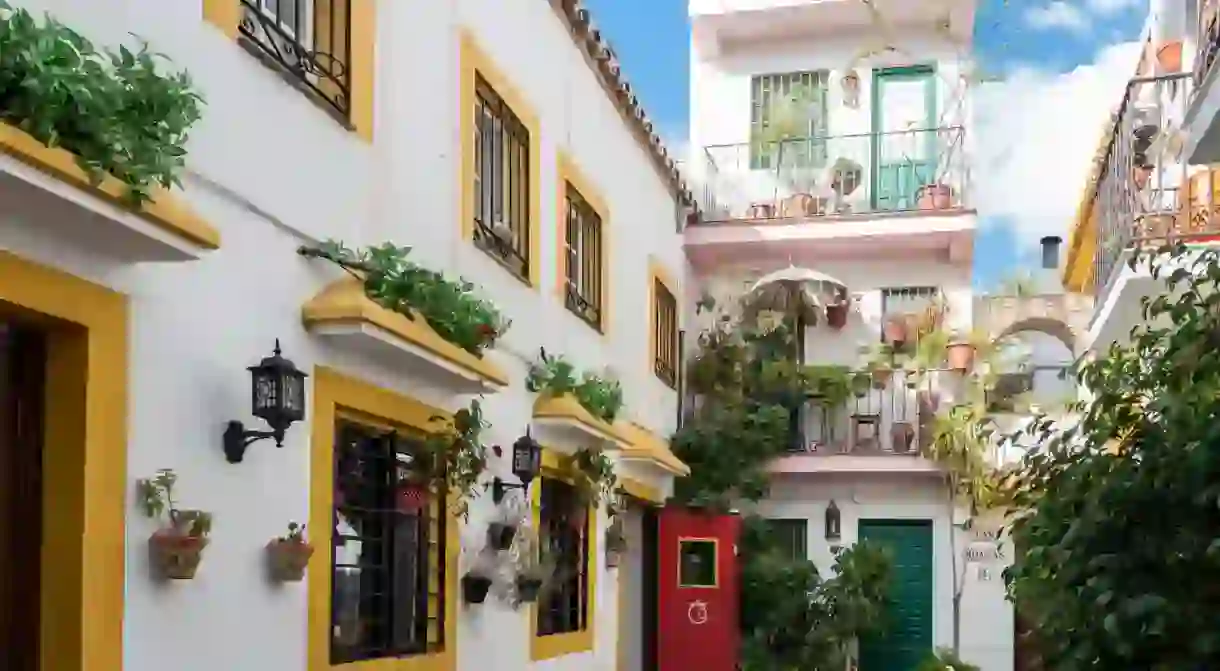How to Spend 48 Hours in Marbella

A 48-hour trip to Marbella provides plenty of time to see everything the city has to offer, from its most lively neighbourhoods to world-famous nightlife. Read on for how to spend 48 hours in this popular Mediterranean destination.
Day 1
Morning
Kick start your 48 hours in Marbella by exploring its several different neighbourhoods. The oldest and most attractive quarter is the casco antiguo, or old town – a barrio every bit as charming as Santa Cruz in Seville and San Basilio in Córdoba. Its pretty cobbled streets are lined with trendy cafés, tapas bars and a selection of upscale boutiques that make Marbella one of Andalusia’s best shopping destinations. The central square is Plaza de los Naranjos – an attractive space filled with orange trees – whilst on Plaza Santo Cristo you’ll find some of the area’s most charming and colourful buildings.

There is much more to Marbella, though, than its beautiful old town. Extending northwards from the beach area are several residential neighbourhoods that richly reward off-piste wandering. For an insightful and fun tour of the city, book yourself on a Marbella Walkabout: run by Liz Glazer – an Englishwoman who’s been living here for 20 years – they reveal a side of Marbella that’s not seen by most visitors.
Lunch
After a morning spent exploring the various neighbourhoods of Marbella, you’ll be ready for a hearty lunch. Avoid the tourist traps that line the Paseo Maritimo and stay instead in the area surrounding Avenida Miguel Cano, which abounds with local joints offering set menus for €10-15. Bar Guerola and the La Lonja seafood restaurant are particularly popular with the locals.
Bar Guerola – 4 Calle Padre Enrique Cantos, Marbella, Spain, +34 952 77 00 07
Restaurante La Lonja – 24 Avenida Miguel Cano, Marbella, Spain, +34 952 86 55 32

Afternoon
After a lesiurely lunch, spend your first afternoon in Marbella visiting its best museums and art galleries. These include the Contemporary Engraving Museum – a collection of 4,000 pieces relating to engraving and graphic art that is unique in Spain – and the Miraflores Cultural Centre. Also worth a visit is the quirky Bonsai Museum, which houses an intriguing collection of miniature specimens as well as several of Europe’s oldest wild olive trees.
Art lovers visiting Marbella will want to check out the Art Wanson Gallery, which is located in the glitzy Marbella Club resort. The permanent collection contains important works by Cézanne, Picasso, Chagall and Bacon.
Museo del Bonsai – Parque Arroyo de la Represa, Avenida. del Doctor Maiz Viñal, Marbella, Spain, +34 952 86 29 26
Art Wanson Gallery – 5 Avenida Bulevar Príncipe Alfonso de Hohenlohe, Marbella, Spain, +34 650 46 31 30

Evening
Marbella is famous for its bars and clubs, so it won’t surprise you to hear that it’s packed with places for a wild night out. The Paseo Maritimo and the streets around the Alameda Park offer many late-night venues for drinking and dancing, including the glitzy Buddha Bar (not for travellers on a budget). If you’re looking for a night out Spanish-style – i.e. lasting until 8am – head to the exclusive Nikky Beach Club, where the world’s best DJs perform every summer. In the clubs and bars along the infamous Golden Mile, meanwhile, you’ll rub shoulders with rock stars and royalty.
Buddha Bar – 3 Avenida Puerta del Mar, Marbella, Spain, +34 628 01 96 63
Nikki Beach – Carretera de Cádiz, Km. 192, Marbella, Spain, +34 952 83 62 39
Day 2
Morning
On your second day, take a morning excursion out to the nearby marina of Puerto Banús. Though often misleadingly described as a part of Marbella city itself, this modern development is situated 8 km (5 miles) to the west. The distance can be pleasantly covered by hiring a bike and cycling – which takes about half an hour – or by walking, for which you should allow about ninety minutes; either way, the path runs directly alongside the Mediterranean and offers some wonderful views.
You’ll know it when you arrive into Nueva Andalusia (New Andalusia) – an area of hotels, casinos, golf courses and apartment blocks that exists solely for tourists. Puerto Banús itself is a millionare’s pleasure park of yachts, Ferraris, smart boutiques and expensive restaurants, the latter of which offer plenty of choice for lunch, provided your wallet can take the strain.

Afternoon
After a morning spent in Puerto Banús, cycle or walk back along the coast and spend your final afternoon on the city’s beaches. The main stretch of sand is the Playa de la Fontanilla, which runs along the southern edge of the centre and backs onto the Paseo Maritimo, a busy promenade lined with bars and restaurants catering for every taste.
Evening
If you want somewhere a little quieter to enjoy your final hours in Marbella, though, keep on walking eastwards and after about ten minutes you’ll find yourself in the city’s old fishing quarter. This is home to the smaller (and often less busy) Playa de la Bajadilla, on the smooth sands of which stand tables belonging to the Puerto Playa seafood restaurant – an unbeatable spot for supper on your final evening in Marbella.
Restaurante Puerto Playa – Playa la Bajadilla s/n, Marbella, Spain, +34 952 86 00 11














